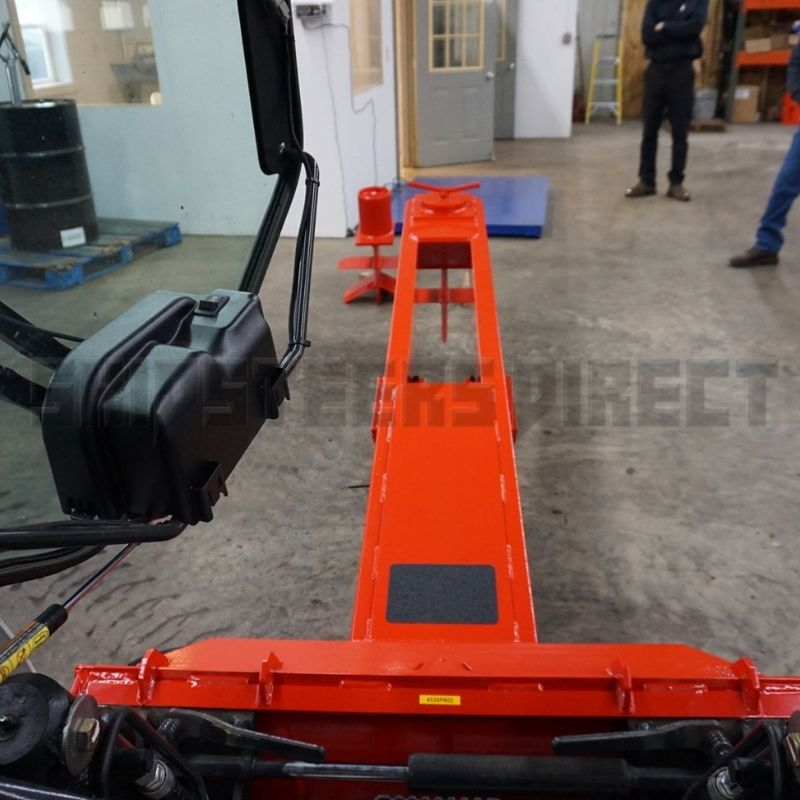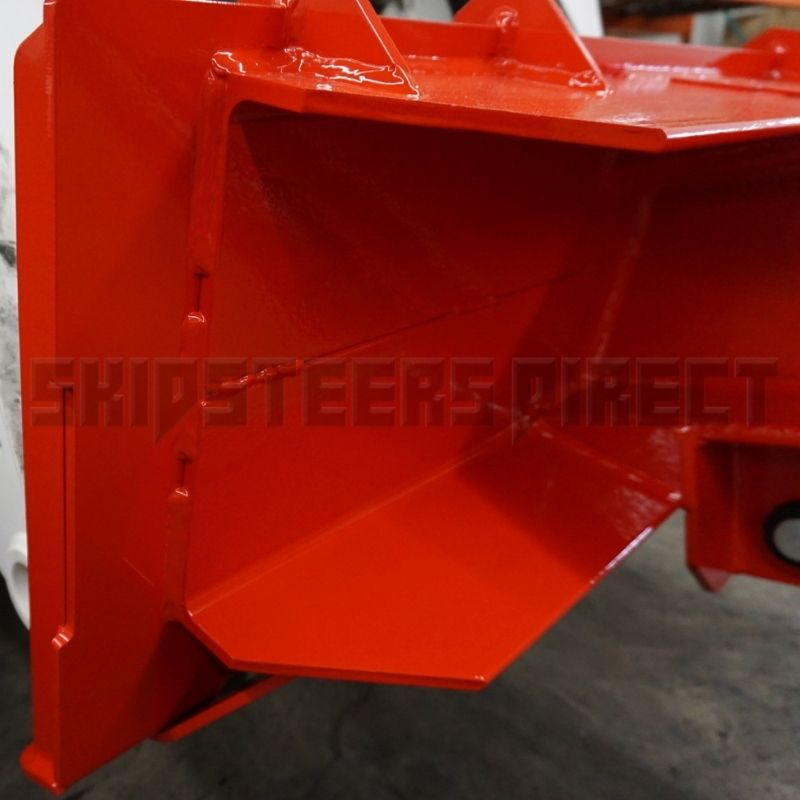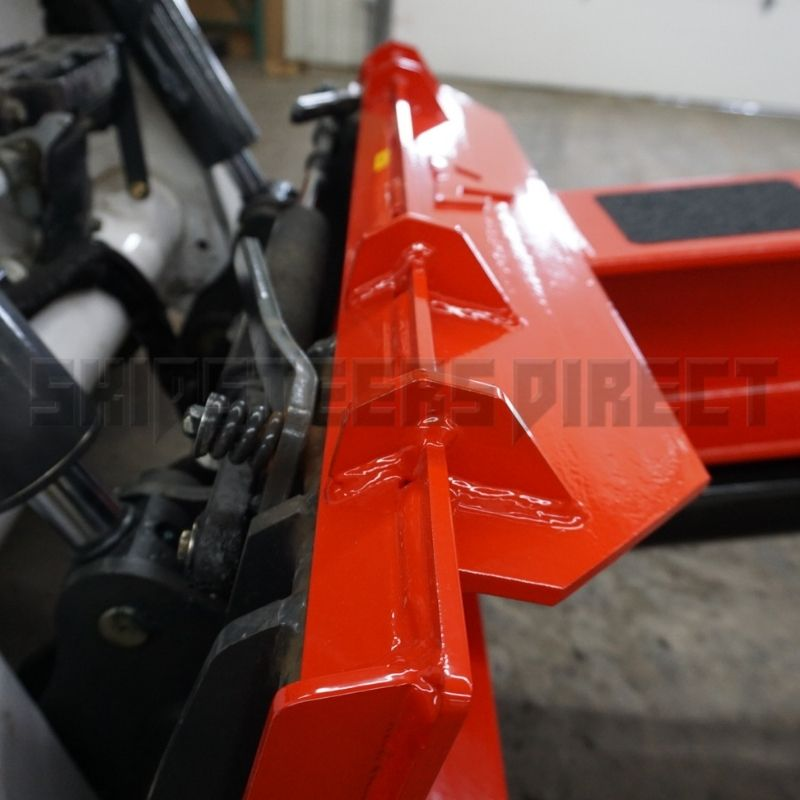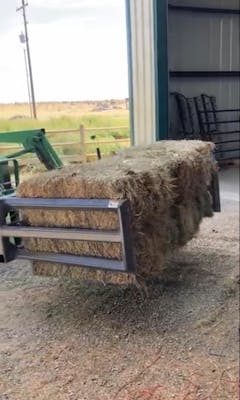
Log Splitter Attachments For Skid Steers
Skid Steer Log Splitters have become a very popular attachment for both at home and commercial use. This is largely because the design of modern skid steers makes them powerful enough to split large logs with ease.
The hydraulic system on modern skid steers is capable of producing upwards of 3,500PSI at 20 to 40 Gallons per minute. When you use this force with a skid steer log splitter, you have the most powerful and efficient way to split logs.
However, with great power comes great responsibility. Buying a skid steer log splitter with to large or small of a cylinder, a weak beam, the wrong wedge, or incorrect style (inverted vs. traditional log splitter) won't do you any good.
To help get you started, we have compiled a few thoughts on what to consider when you are shopping around for your first skid steer log splitter attachment.
Traditional vs Inverted Skid Steer Log Splitter Attachments
When you are shopping for any skid steer attachment, the first place to start is with the overall design.
With log splitter attachments, there are two main designs to consider, Traditional and Inverted.
The traditional log splitter has the wedge on top of the beam and requires the logs to be manually loaded into the splitter. The inverted style log splitter turns the traditional upside down and splits the wood below the beam.
The important distinction between the two is that the traditional style log splitter requires the logs to be manually loaded into the splitter. In order to manually load, an outside helper is required, and heavy logs need to be lifted.
With an Inverted Log splitter, you can use your skid loaders arms to position the splitter over the wood while it rests on the ground.
And as you'll learn below, an inverted log splitter with a viewing window is ideally the best option for any skid steer.
Log Splitter Wedges
The most common style of wedges for skid steer log splitters is single wedge or 4-way wedge. Be sure you know which one your new log splitter comes with.
Some models such as Blue Diamonds 35 Ton Inverted Log Splitter come with the option of single or 4 way wedge (purchased separately), while other models such as TM Manufacturings Pro 2 Series Log Splitter come standard with a single and 4 way wedge, while still providing the option for an additional 6 way wedge.
Log Splitter Stroke
The first consideration is how long the logs are that you are planning on splitting. But this needs to be balanced against how quickly you want to be able to cycle the log splitter when you have a large pile of wood to split. A shorter stroke could result in faster split times than longer strokes.
TM Manufacturing provides skids steer log splitters with 24”, 30” and 36” strokes depending on the model you are choosing. 30” is the most popular option.
Blue Diamond’s traditional 25 ton log splitter offers a 24” stroke while the larger 35 ton inverted log splitter opens up to 30”
Top Dog Attachments offers both 30” and 36” strokes in their 20 ton skid steer log splitters, while Berlon Industries offers one model with a 24” stroke and one with a 30” stroke.
How Big of a Cylinder Do I Need?
Most skid loader log splitter manufacturers will publish how many tons of force their log splitters are capable of producing. Ordinarily you’ll be looking at 20 to 35 tons depending on the model you choose.
This is where the size of the cylinder bore comes into play. The tonnage that a wood splitter is capable of producing is dependant on the size of the wood splitters cylinder and the skid steers auxiliary hydraulic PSI.
For example, if you are able to obtain 3500psi in your skid steers hydraulic system and have a large 5” cylinder bore on your wood splitter, you will produce about 35 tons of force. The same 5” cylinder will produce 30 tons of force at 3,000psi and 25 tons at 2,500psi. A more common 4” cylinder will be about 5 tons less at the same PSI.
You may be thinking to yourself, why would I go with a 4” cylinder if I can get 5 tons more force with a 5” cylinder? As with everything, there is a trade off..
A larger cylinder will be slower to cycle than a smaller one. This makes the 4” cylinder faster acting and able to split more wood in a given amount of time than a 5” cylinder. Therefore, we recommend getting the largest cylinder you need, but nothing extra.
How Many Tonnes Do I Need?
You need to consider what you are planning on doing with your wood splitter when deciding on the correct tonnage. Three main things should be considered.
What length of logs will you typically split? Longer logs require more splitting force than shorter ones. This is because the wedge will encounter more resistance overall in a 36” log than a 20” log. A 24” log would need at least 20 tons while a 36” log is likely to require closer to 30-35 tons.
Are your logs seasoned or green? Green wood is heavier due to the higher moisture content. If you are planning on splitting green wood you should consider a higher tonnage than if your only splitting seasoned wood.
For example, a 24” seasoned log would likely split just fine with 20 tons of force, but if the same log was green, it may require closer to 30 tons.
A finally, you’ll want to consider if your planning on splitting hard or soft wood. Hard woods such as oak, maple and hickory will require a higher tonnage than soft woods such as spruce, cedar and pine.
Should I Have a Viewing Window In My Log Splitter?

You can quickly narrow down your need for a viewing window by first asking yourself if you are wanting a traditional style wood splitter, and an inverted model.
Traditional style skid steer log splitters are less common than inverted models. By “traditional” we mean that the logs are placed on the top of the wood splitter by an outside assistant. With inverted log splitters, the wood is split underneath the log splitter. The inverted models eliminate the need for an outside assistant because the skid steer operator can lift logs off the ground and split them using only the controls in the skid steer.
An important note to consider is the safety benefit of not needing an outside assistant when using an inverted skid steer log splitter.
So, if you’ve decided on an inverted wood splitter, now you need to decide if you want a viewing window or not. The viewing window is intended to allow the skid steer operator to be able to see through the splitter. This is helpful not only for picking up the logs, but also to see when the log has been fully split, helping to reduce splitting times.
Not many skid steer log splitter manufacturer’s offer viewing windows. If you’ve decided that a viewing window is right for you, you’ll have to go with TM Manufacturing’s Pro or Pro 2 series log splitter. These two models by TM Manufacturing are very impressive attachments, and are by far our most popular skid steer wood splitters.
What Regular Maintenance Is Required On My Log Splitter?
One of the greatest advantages of a skid steer log splitter is that they require minimal maintenance.
Be sure to follow your manufacturers recommendations, but overall, you are just looking at occasional greasing and cleaning.
High quality log splitters will have grease zerks installed in order to keep the sliding wedge lubricated along the length of the I-beam. Applying a shot of grease before use to keep the splitter running smoothly is recommended.

This I-beam area should also be kept clean from debris. Dirt, leaves and saw dust can easily build up in these areas.
You should also regularly inspecting your hydraulic cylinder for leaks and your welds for cracks.
What Else Makes For a Great Skid Steer Log Splitter?
Just like with any other skid steer attachment, you want to pay attention to the details. This is specially important when you are going to be applying 30 tons of force to split logs.
We have heard several instances of cheaply built, bent log splitters that weren't able to sustain the forces exerted on it by the skid steer. So the begin with, your log splitter should be built from a heavy I-beam.
The I-beam should have heavy gussets connecting it to the attachment plate. On many models, the hydraulic cylinder is applying pressure to the wedge from the back of the I-beam so this can be an area of great force.


You should also consider models that give you multiple wedge options, and allows you to easily change wedges in the field. Not only will this provide more versatility, it also helps your log splitter retain resale value.
Lastly, we always recommend inverted style log splitters over traditional splitters. This comes down to ease of operation, and not needing to manually load large logs.
Wrapping it up
Getting the right log splitter for your skid loader makes splitting piles of wood a satisfying experience. No body should throw their back out lifting and manually splitting logs.
Having an eye for detail and ensuring your log splitter will last as long as your skid loader is of prime importance. This is where we come in to help.
Start by reading our blogs, have a look at our splitters, and call us if you have any other questions. Our sales team can give you a quick response to your questions, and help get you the right log splitter.
For more information view our Best Skid Steers Log Splitters in 2021 Article. Take me to learn more.
(Click this link to learn more about TM Manufacturing Log Splitters)
















